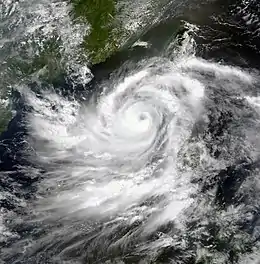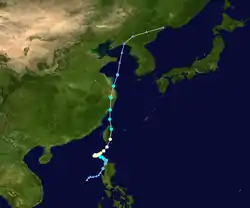Typhoon Kai-tak (2000)
Typhoon Kai-tak, also known in the Philippines as Typhoon Edeng, was a typhoon that formed in July 2000 and brought severe impacts to the Philippines and Taiwan.
| Typhoon (JMA scale) | |
|---|---|
| Category 1 typhoon (SSHWS) | |
 | |
| Formed | July 3, 2000 |
| Dissipated | July 10, 2000 |
| Highest winds | 10-minute sustained: 140 km/h (85 mph) 1-minute sustained: 140 km/h (85 mph) |
| Lowest pressure | 960 hPa (mbar); 28.35 inHg |
| Fatalities | 188 total |
| Areas affected | Philippines, Taiwan, East China, Korea |
| Part of the 2000 Pacific typhoon season | |
Meteorological history

On July 2, a low pressure area formed north west of the Philippines and became a tropical depression on July 3 and started to drift northward, becoming a storm on the 5th and a typhoon on the 6th. Kai-tak continued northward, hitting Taiwan on the 9th. Kai-tak changed to an extratropical cyclone in the Yellow Sea on the 11th.[1][2] This extratropical cyclone landed near the Dandong city of the Liaodong Peninsula and changed course to the east, and disappeared on the 12th.[1]
Name
This typhoon was named after Hong Kong's old international airport, Kai Tak Airport. PAGASA gave the storm the name Edeng.
Impact
The combined effects of Kai-tak and Tropical Depression Gloring led to the collapse of a large garbage pile, devastating a scavenger community with 300 shanty homes near Manila. At least 116 people died in the avalanche—some of whom were decapitated by machinery—and at least 73 others were injured.[3] 160 people were killed and 150 were missing on Luzon due to heavy rain and landslides.[4] In Taiwan, a wind of 80 knots or more when landing caused a power outage of more than 3,000 units, killing one person.[4] The China Meteorological Administration allegedly suffered an economic loss of $82 million in Zhejiang and elsewhere.[4]
References
- Annual Report on Activities of the RSMC Tokyo - Typhoon Center 2000、P.25
- "デジタル台風:台風200004号 (KAI-TAK) - 詳細経路情報". agora.ex.nii.ac.jp. Retrieved 2020-08-12.
- "Death toll rises to 116 as disease fears grow in Philippine dump". ReliefWeb. Agence France-Presse. July 12, 2000. Retrieved May 15, 2016.
- Annual Tropical Cyclone Reports. P.47
